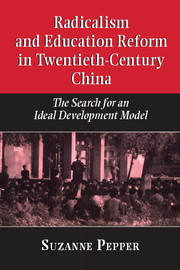Book contents
- Frontmatter
- Contents
- Acknowledgments
- 1 Educational development and the Chinese experience
- Part I The republican era: origins of radical education reform
- Part II Learning from the Soviet Union
- Part III Cultural revolution and radical education reform
- 11 On Stalin, Khrushchev, and the origins of cultural revolution
- 12 The great leap in education
- 13 A system divided: walking on two legs into the 1960s
- 14 Education reform as the catalyst for cultural revolution and class struggle: the 1966–1968 mobilization phase
- 15 Education reform as the culmination of class struggle: the professional educator's perspective
- 16 Education reform as the culmination of class struggle: the critical ideals triumphant at last
- 17 The Cultural Revolution negated
- 18 The mixed triumph of regularity
- 19 Chinese radicalism and education development
- Appendix: the Hong Kong interviews
- Select bibliography
- Index
17 - The Cultural Revolution negated
Published online by Cambridge University Press: 04 August 2010
- Frontmatter
- Contents
- Acknowledgments
- 1 Educational development and the Chinese experience
- Part I The republican era: origins of radical education reform
- Part II Learning from the Soviet Union
- Part III Cultural revolution and radical education reform
- 11 On Stalin, Khrushchev, and the origins of cultural revolution
- 12 The great leap in education
- 13 A system divided: walking on two legs into the 1960s
- 14 Education reform as the catalyst for cultural revolution and class struggle: the 1966–1968 mobilization phase
- 15 Education reform as the culmination of class struggle: the professional educator's perspective
- 16 Education reform as the culmination of class struggle: the critical ideals triumphant at last
- 17 The Cultural Revolution negated
- 18 The mixed triumph of regularity
- 19 Chinese radicalism and education development
- Appendix: the Hong Kong interviews
- Select bibliography
- Index
Summary
Local cadres and educators worked to fulfill the terms of their new revolutionary contract, but the contract itself was far from static. School growth and all the details of daily management proceeded, especially in rural communities, with a routine logic belying both the 1966–1968 explosion itself and the continuing turbulence within the Beijing center. The mass movement may have achieved its purpose in creating a new political leadership and a new agenda of revolutionary policy objectives. But no sooner did the new order begin to take shape than the “forces of opposition” it was intended to replace also began to regroup as the sequential laws of the mass movement proceeded through its consolidation phase.
Ensuing controversies in the early 1970s were portrayed officially as part of the “two-line struggle,” which was now a contest between the victorious Maoist mainstream and remnants of a defeated enemy. Overall, the struggle was registered in the manner of an ongoing series of post-1968 aftershocks, still radiating outward from Beijing but in a circle of ever diminishing intensity which might pass with barely a tremor through entire counties.
At the time, observers were inclined to dismiss the ongoing campaigns and controversies as symptoms of some unprincipled power play. Certainly, no one could believe the shrill charges that there were still enemies within the CCP bent on “walking the capitalist road.” In retrospect, of course, the polemics of the early 1970s anticipated the beginning of the revolutionary end far more accurately than anyone knew. Still, it was only in death that Mao finally lost command of the mass movement.
- Type
- Chapter
- Information
- Radicalism and Education Reform in 20th-Century ChinaThe Search for an Ideal Development Model, pp. 466 - 490Publisher: Cambridge University PressPrint publication year: 1996



